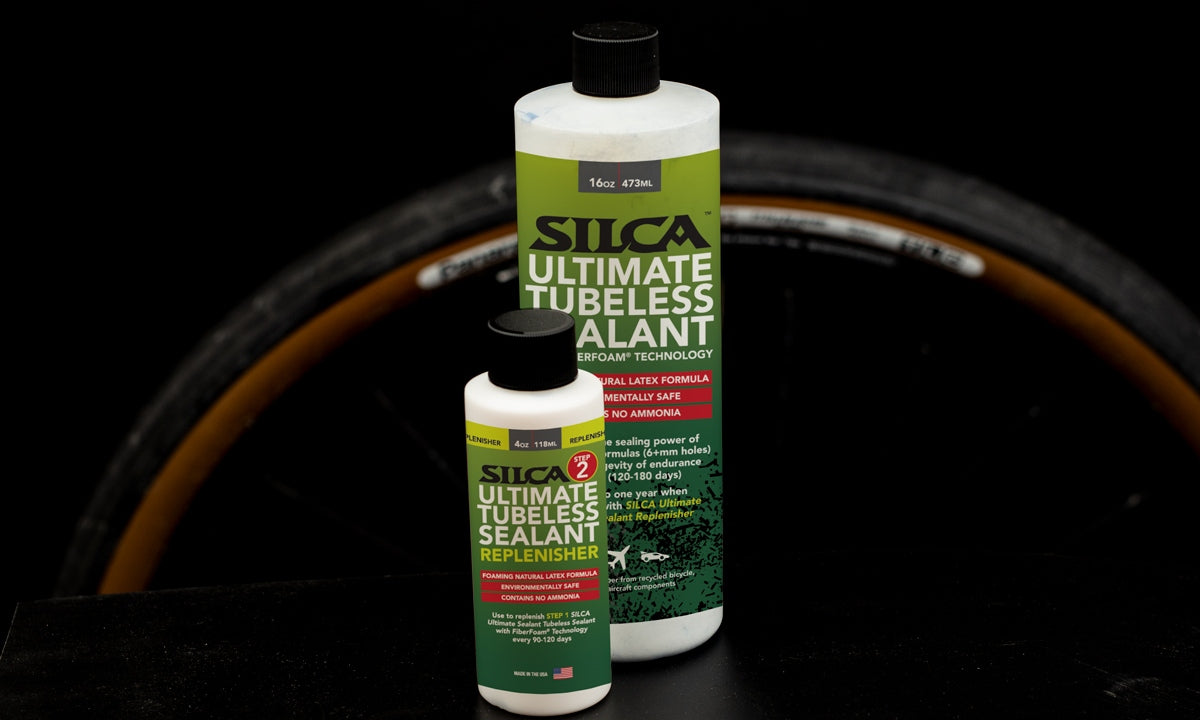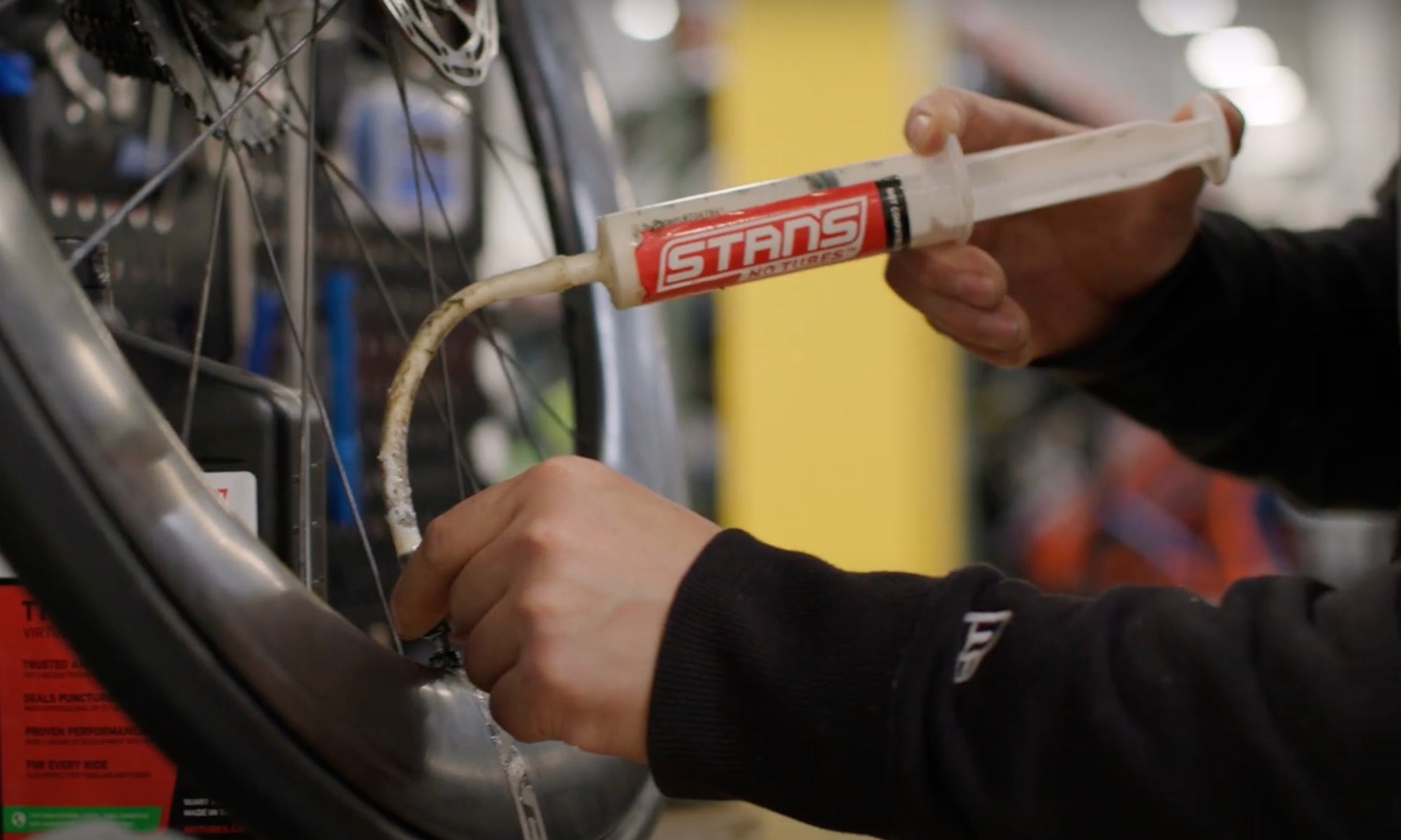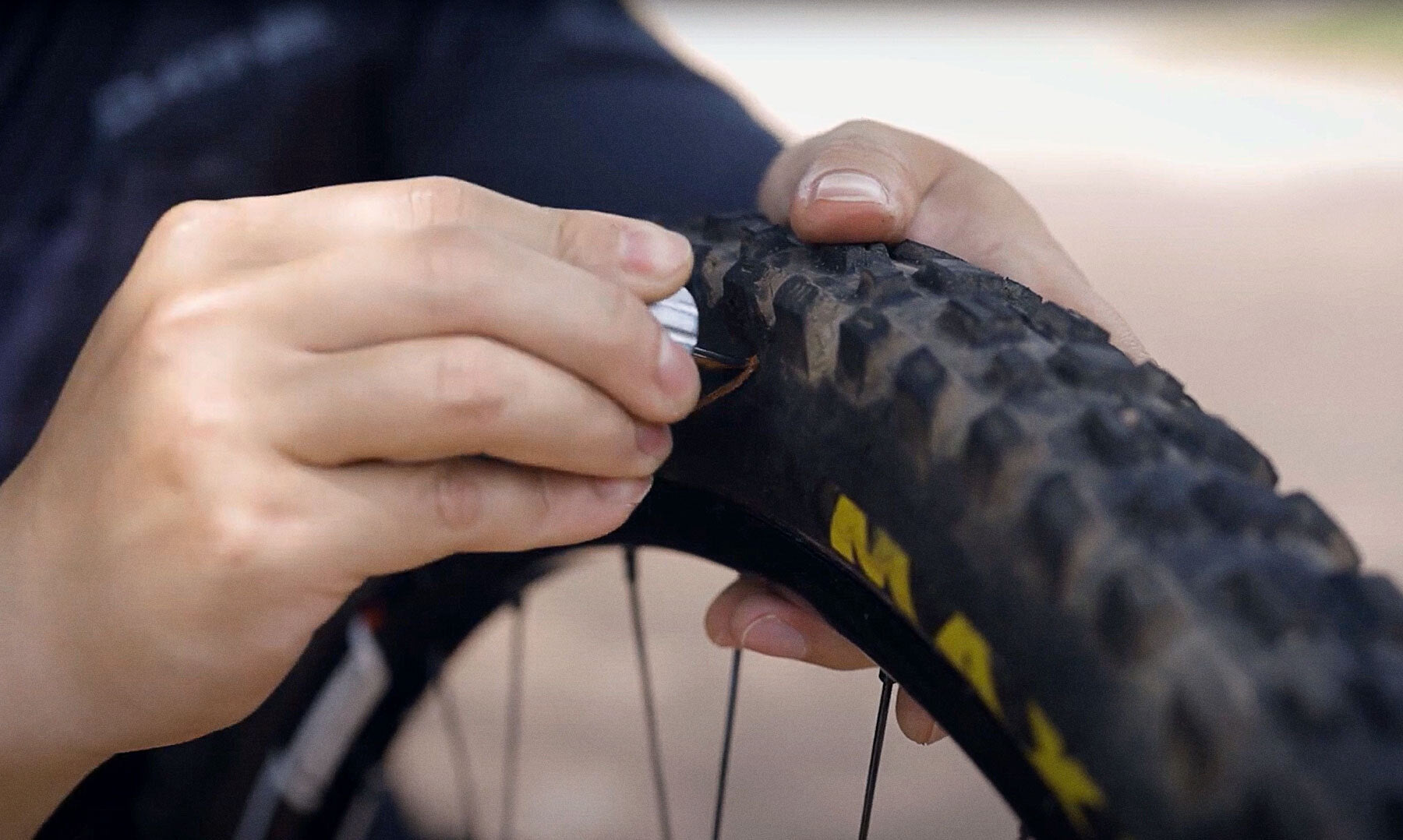What sealant am I pouring in? Does it even matter anymore?
Tubeless tire sealants can be a pretty contentious topic. You might already have a favorite sealant, and many riders will have stories about how your favorite failed or was ineffective. I’ve been riding tubeless for 10 years now, tried a lot of different sealants, and experienced a lot of success and disappointment.
After testing many of the popular sealant options, I have developed a very strong opinion about which sealants I think are the most effective at sealing punctures. Despite that, I actually don’t regularly use these sealants on my own bikes. In fact, I’m not sure that using the "best" sealant is actually that important to me anymore. Here’s why.
[button]Shop Tubeless Accessories[/button]
My Favorite Tubeless Tire Sealants
 The actual bottles of sealant I have in my garage right now.
The actual bottles of sealant I have in my garage right now.
- The sealant with the best puncture protection: Silca Ultimate or Stan’s NoTubes Race
- The sealant I actually use: Regular Stan’s NoTubes or Orange Seal Endurance
The Best Sealant for Puncture Protection

[product-block handle="7392024494272-silca-ultimate-tubeless-sealant"/]
Silca Ultimate makes bold claims about its sealing capabilities and it also uses some cool carbon fiber tech to boost its sealing capabilities. To me, it’s the best at sealing punctures because I’ve had extremely good luck with it plugging up decent-sized holes and cuts (in the 5-8mm range) in my gravel and mountain bike tires.
 The main particulate Silca uses in its sealant is recycled, environmentally friendly carbon fiber. Here, it sealed a ~4-5mm puncture in my Vittoria Corsa Pro and still held 60+ psi after.
The main particulate Silca uses in its sealant is recycled, environmentally friendly carbon fiber. Here, it sealed a ~4-5mm puncture in my Vittoria Corsa Pro and still held 60+ psi after.
It's also the best sealant I’ve ever used with thin and high-pressure road tires. I find that most tubeless sealant is pretty ineffective at maintaining a seal for medium to large-sized punctures in road tires inflated above 60 PSI. Silca Ultimate is one exception. I’ve already had it seal several road punctures over the last year with pretty minimal air loss, and every time I’ve been impressed with how quickly it seals and how it can hold high pressures without needing a tire plug.
I do still need to use a plug from time to time, but Silca Ultimate is without question the fastest sealing and most consistently effective sealant that I’ve ever tried. That’s why it’s become my go-to sealant for racing.
 Silca Ultimate was able to seal this bad cut. I just added some air and rode out. (I did plug it later when I got home.)
Silca Ultimate was able to seal this bad cut. I just added some air and rode out. (I did plug it later when I got home.)
There is a major downside though — it’s quite high maintenance. Silca Ultimate is effective enough that it easily clogs your tubeless valves. It can’t be injected through the valve during the initial tubeless set-up or when you need to refresh the sealant. You have to pop the bead and pour it directly into the tire, which can be a hassle, especially if you run tire inserts. Silca does offer a “replenisher” that can be injected, but I personally find it annoying to have to buy two products just to keep your sealant topped up.
To prevent valve clogs, you also need to be conscious of where the valve is located when pumping up your tires. If you pump up your tires with the valve in the 5-7 o’clock position, it’s very likely that the sealant will splash up into the valve and instantly clog it, requiring you to clean the valve core or replace it. Sometimes, sealant likes to just hang out in the valve, and you won’t notice until you open the valve and it sprays out when you attach your pump.
My current routine before inflating tires filled with Silca Ultimate is to rotate the valve to 6 o’clock for a couple of seconds to ensure any sealant sitting in them drains out. Then I rotate the valve back to 9 o’clock, open the valve, and attach the pump. It’s annoying, but this is the best way I’ve found to avoid clogs. Even when I’m careful though, I still manage to clog my valves occasionally. I haven’t tried clog-resistant valves like Reserve Fillmore valves yet because they’re pretty expensive, but they might be the solution to this annoyance.
[product-block handle="7471929229504-reserve-fillmore-tubeless-valves-pair"/]
Silca Ultimate also tends to be a very messy sealant during installation, removal, and refreshes. It creates sticky webs between everything and anything it touches, which is impressive to see, but it can be hard to clean when it inevitably gets all over your rims, tires, clothes, and floor.
My biggest gripe with it though is that it seems to dry up fairly quickly, usually only lasting 2 months or so before my tire stops holding air and I have to do a refresh or add the replenisher. Let your tire sit for too long in one position while it dries out, and you might need to remove a massive sealant booger the next time you clean your tire out. But if you want ultimate puncture protection, it’s the sacrifice you have to make.
[product-block handle="5970379014336-stan-039-s-notubes-race-tubeless-tire-sealant-32oz"/]
A possible alternative is Stan’s NoTubes Race sealant. I think it is actually close to Silca Ultimate in terms of its puncture-sealing capabilities. Unsurprisingly though, it has the same valve-clogging issues and short lifespan as Silca Ultimate, but I do think it feels a bit less sticky and messy during the initial setup.
 Both Silca (top) and Stan's Race (bottom) are capable of making spectacular sealant boogers. It's a sign of how much puncture plugging power they have, but they can be a chore to clean and they mean your sealant is drying up.
Both Silca (top) and Stan's Race (bottom) are capable of making spectacular sealant boogers. It's a sign of how much puncture plugging power they have, but they can be a chore to clean and they mean your sealant is drying up.
I used Stan's Race for a few years, and main reason I stopped is kind of silly. The latex and particulates in Stan’s Race tend to ball up into weird little spherical “boogers” over time. After a month or less, you’d find a handful rolling around when you reopen your tire for a sealant refresh. It weirded me out and I can only imagine that boogers like these reduce the sealant’s effectiveness over time as the particulates used to seal punctures coagulate.
The Sealant I Actually Use on a Regular Basis

For me, being able to inject sealant through the valve during setup and refreshes keeps things cleaner and makes life easy.
[product-block handle="5970378850496-stan-039-s-notubes-tubeless-tire-sealant-16oz"/]
[product-block handle="5970378948800-orange-seal-endurance-tubeless-tire-sealant-with-twist-lock-applicator-8oz"/]
I use Silca Ultimate for racing, but it’s a serious hassle when I’m not racing. Including my wife’s bikes, I have 7 bikes in the garage to maintain. Keeping Silca Ultimate topped up and valves unclogged on all 7 bikes is a bit of a nightmare. So for most of the year, our bikes are actually set up with basic Stan’s NoTubes sealant or Orange Seal Endurance sealant. The main reason is for longevity and low maintenance.
These sealants are easy to inject through a valve and they require no weird pumping routines. They’re also available at nearly every bike shop and tend to last 6+ months in my tires. I’ve personally also had decent luck with them sealing medium-size punctures, with both sealants successfully sealing a few holes in the 3-4mm range.
I say “a few” though because I’ve also had plenty of 3-4mm punctures that seemed like they should seal but didn’t. This sounds bad, but it’s also pretty much what I’ve experienced with nearly every other sealant too. Because of this, I just don’t stress about it.
Even if I try other new sealants, I always tend to revert back to using the most readily available and generally reliable options — Stan’s and Orange Seal.
Why Do I Willingly Use a “Worse” Sealant?
 I trust tire plugs more than any sealant available.
I trust tire plugs more than any sealant available.
All sealants have trade-offs. A sealant that is easy to inject through a valve and lasts a long time simply won’t be as effective at stopping punctures as something more aggressive like Silca Ultimate. But most of the time, that’s what I prefer.
Riders focus a lot on puncture protection, but the main job of tubeless sealant is to make a tubeless-ready wheel and tire combo airtight. I think of sealing punctures as kind of a side gig. If you’re truly worried about punctures, then a more puncture-resistant tire is going to be much more effective than any sealant.
There’s also only one thing I know to be 100% true after my 10 years of riding tubeless: EVERY sealant will inevitably fail to seal a puncture that you expect it to be capable of sealing.
That’s why I always carry tire plugs in my flat kits and I never hesitate to use them. I’ve learned that if a puncture doesn’t seal in less than a second, it doesn’t matter what sealant I have in my tires, I should just stop immediately and jam a plug in it. It’s much better than waiting around, losing air and sealant, and hoping that a seal forms.
[product-block handle="genuine-innovations-tubeless-tackle-tire-repair-kit-with-bacon-1"/]
Tire plugs are one of the best perks of running tubeless, and they are so reliable and easy to use that I rarely carry spare tubes anymore. If I always have tire plugs (I always carry at least 5 bacon strips) to fall back on, then I don't see a lot of reason to run an aggressive sealant on a daily basis. I’d rather use the sealant that’s easier to live with and requires less attention.
I’ll still use Silca Ultimate in races because its powerful sealing capabilities reduce the air loss from bad punctures. In a race situation, losing less air means you save time and effort when airing your tire back up. You might not have to air back up at all if you’re fast enough. Once a race is over, however, and the Silca Ultimate dries up, I’ll make my life easy and refill my tires with Stan’s or Orange Seal Endurance.
Note: Technically, you’re not supposed to mix sealants (though I have done it plenty of times), especially when some sealants contain ammonia and some don't. If you’re switching between sealants, the best practice is to clean out the old sealant before adding the new sealant.
Final Thoughts
These days, I find myself caring a lot less about what sealant I’m using. While I do think Silca Ultimate is the best on the market at sealing punctures, I don’t want to deal with it all the time. Stan’s and Orange Seal Endurance are easy and plentiful. Between the two I usually just choose whichever I can get the quickest or at the best price. Again, as long as I have tire plugs, I don’t think the choice is that important.
Over the years, I’ve also tried Orange Seal (the non-endurance version), Caffelatex, Muc-Off, WTB TCS, Challenge SMART, Specialized 2Bliss, Peaty’s, Finish Line FiberLink, Vittoria Universal, and even some homebrew sealant one of our mechanics cooked up.
[product-block handle="5970379112640-muc-off-no-puncture-tire-sealant-1-liter"/]
I’ve had fairly similar luck with all of these sealants, which is why I’ve become so laid-back about my sealant choices. My other two favorites are probably Caffelatex and Muc-Off. For me, they seemed to seal punctures a bit better (maybe even better than Stan’s and Orange Seal Endurance actually), and they both last around 6 months for me, so they’d likely be my first pick if my own shop didn’t have so many bulk bottles of Stan’s or Orange Seal Endurance in stock. If you’re turned off by Stan’s or Orange Seal, I think they’re the best alternatives.
Of course, you’ve likely had completely different experiences from me. I’m guessing some might even be completely disgusted with my choices! If so, let me know which sealant YOU think is the best.
[button]Shop Tubeless Accessories[/button]
























